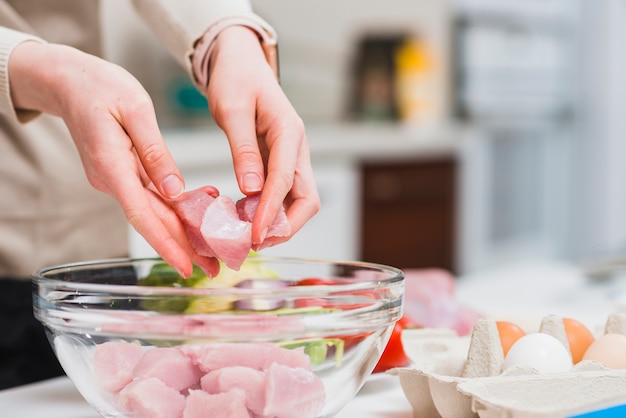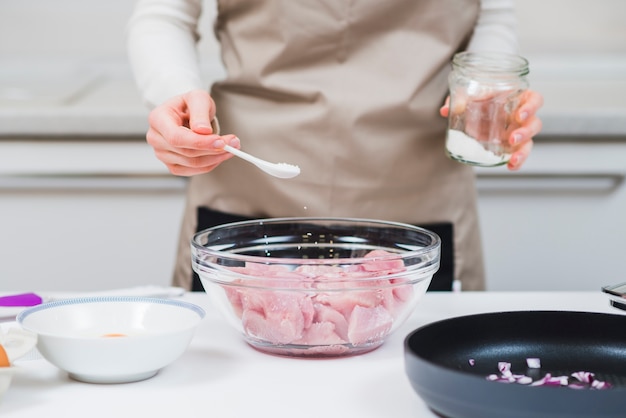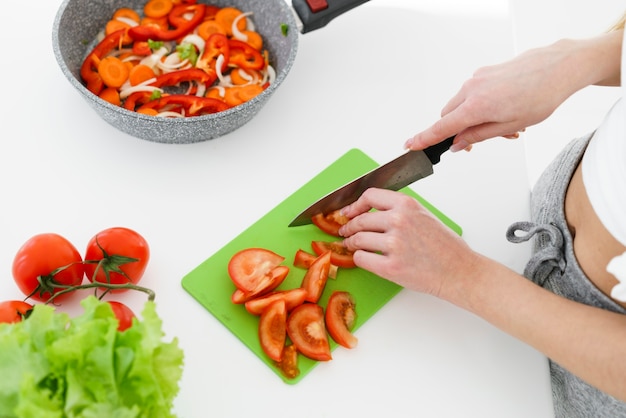You’ve probably seen it everywhere: colourful, flexible silicone cookware promising easy cleanup and the ability to withstand even the most intense heat. But is it all hype? Is this newfangled stuff really safe to cook with? As a seasoned home cook who’s seen a fair bit of kitchen kit come and go, I’m here to tell you that silicone cookware has become a real staple in my kitchen, and it might just make your life easier too. But before you go full-on silicone and buy everything in sight, there are a few things you need to know about its safety. So, grab a cuppa, settle in, and let’s delve into the world of silicone cookware together, shall we?
Part 1: The Rise of Silicone Cookware

Remember when silicone first started appearing in kitchens? I was a bit sceptical, to be honest. It seemed too good to be true: this smooth, flexible, and colourful stuff promising to make cooking a breeze. I thought, "Surely this is just a passing fad." But then I started seeing it everywhere – from baking pans to spatulas to even those funky ice cube trays. And guess what? It stuck around. And for good reason, I might add.
Why All the Fuss?
Silicone cookware’s popularity is well-deserved. It’s super versatile: you can bake, roast, and even microwave food in it. It’s incredibly non-stick, making cleanup a breeze. And let’s not forget its durability; you can drop it, scratch it, and it’ll bounce right back, unlike those fancy non-stick pans that get all scuffed up after a while. Plus, it’s lightweight and easy to store. Who doesn't love a bit of convenience in the kitchen, right?
Part 2: The Silicone Safety Debate

Now, here’s where things get a bit more complicated. We've all heard those whispers about silicone not being the safest thing in the world, right? There’s been a lot of talk about potential health risks, especially when it comes to heat. Let’s face it, nobody wants to be eating chemicals with their dinner. So, what’s the deal with silicone safety? Is it all just scaremongering, or is there some truth to it?
The Good, the Bad, and the Ugly of Silicone
Let’s break down the silicone safety debate into three main points:
1. The Good:
- Silicone is a stable material: It’s basically inert, meaning it doesn’t easily react with food or other materials. This means it won’t leach harmful chemicals into your food even at high temperatures. That’s a big plus in my book.
- Silicone is FDA approved: That’s right, the Food and Drug Administration in the US has approved silicone for food contact, meaning it’s deemed safe for use in food preparation. It’s worth noting that not all countries have the same regulations, so it’s wise to check the regulations in your area.
- Silicone is generally resistant to heat: You can usually chuck it in the oven or microwave without any issues. Just check the manufacturer's recommendations for specific temperature limits.
2. The Bad:
- Not all silicone is created equal: Some manufacturers use low-quality silicone that might not be as heat-resistant. It's crucial to buy from reputable brands that use high-quality silicone.
- Silicone can leach chemicals at extremely high temperatures: While generally considered safe, some studies have shown that certain types of silicone can leach some chemicals at extremely high temperatures, like those found in industrial settings. This is not something you need to worry about in a home kitchen. Just use common sense and follow those temperature guidelines.
3. The Ugly:
- The debate about “leaching” is still ongoing: Some experts argue that the chemicals that are released at very high temperatures are negligible and pose no real risk. Others say more research is needed. It's a tricky one, and it's hard to say definitively what the long-term effects might be. But, again, remember the saying “better safe than sorry.”
Part 3: How to Choose Safe Silicone Cookware

So, how do you navigate this whole silicone safety thing and make sure you’re choosing the best stuff for your kitchen? It’s actually easier than you might think. Here’s a little checklist to help you out:
1. Look for the Right Label:
The first thing to look for is the "FDA Approved" label. This tells you that the silicone has been tested and deemed safe for food contact in the US. While not all countries have the same regulations, it's a good starting point. Remember, looking for reputable brands is key. They are more likely to use higher-quality silicone and follow stringent safety standards.
2. Check the Brand:
Stick with well-known brands that have a good reputation for quality and safety. These brands are usually more transparent about the materials they use and the manufacturing process. It’s worth doing a bit of online research and reading reviews before you buy.
3. Pay Attention to the Temperature Limits:
Every silicone product will have a maximum temperature rating. Be sure to follow these guidelines and avoid using it at temperatures higher than what’s recommended. Remember, it’s better to be safe than sorry.
4. Consider Your Needs:
Do you need a baking pan that can withstand high temperatures? Or a spatula for everyday cooking? Different products will have different temperature ratings. Match the product to your needs and use it accordingly.
Part 4: Silicone Cookware vs. Other Options
Okay, so now you’re starting to get the hang of silicone cookware and its safety. But how does it stack up against other popular kitchen tools? Let’s compare it to some of the old favourites.
Silicone vs. Non-Stick Pans
| Feature | Silicone Cookware | Non-Stick Pans |
|---|---|---|
| Heat Resistance | High heat resistance (check temperature limits) | Limited heat resistance (can warp or scratch at high temperatures) |
| Durability | Durable and scratch-resistant | Can scratch and wear over time |
| Cleaning | Easy to clean | Can be difficult to clean, especially if food is burnt |
| Cost | Generally more expensive | More affordable |
As you can see, silicone cookware generally wins out in terms of durability, heat resistance, and ease of cleaning. However, it can be a bit pricier. Ultimately, the best choice depends on your individual needs and budget.
Silicone vs. Metal Cookware
| Feature | Silicone Cookware | Metal Cookware |
|---|---|---|
| Heat Conductivity | Poor heat conductivity | Excellent heat conductivity |
| Weight | Lightweight | Heavy |
| Durability | Durable and scratch-resistant | Durable, but can dent or scratch |
| Cleaning | Easy to clean | Can be difficult to clean, especially if food is burnt |
Metal cookware is still the gold standard when it comes to even heat distribution. However, silicone wins out in terms of ease of cleaning and durability. Plus, silicone is much lighter than metal, which is a real plus if you’re constantly lifting heavy pots and pans.
Part 5: Using Silicone Cookware Safely
Okay, so you’ve decided to give silicone cookware a try. Great! But remember, just like any kitchen tool, it’s important to use it properly and safely. Here are a few tips to keep in mind.
1. Follow the Temperature Guidelines:
Always check the manufacturer's recommendations for the maximum temperature that the silicone can withstand. Avoid using it at temperatures higher than what’s recommended, as this could cause it to degrade or release harmful chemicals. If a recipe calls for high heat, consider using your trusty metal cookware instead.
2. Avoid Extreme Heat Changes:
Don't put your silicone cookware directly from the freezer into a hot oven. This sudden change in temperature can cause it to crack or deform. Always let it warm up gradually or cool down before making drastic temperature changes.
3. Don’t Use Sharp Objects:
While silicone is pretty durable, it’s still susceptible to punctures and cuts. Avoid using sharp knives or forks directly on the silicone, and be careful when storing it. It’s a good idea to keep it separate from your other kitchen utensils.
4. Clean It Properly:
Silicone cookware is usually dishwasher safe, but always check the manufacturer’s instructions. It's best to hand wash it with warm, soapy water and a soft sponge to avoid damaging it. If you do choose to put it in the dishwasher, make sure it’s on the top rack to avoid potential damage from the heat and pressure.
5. Store It Properly:
Store your silicone cookware in a cool, dry place. Avoid storing it in direct sunlight or near heat sources. This will help to prolong its lifespan. Also, make sure to store it in a way that prevents it from being crushed or punctured.
Part 6: Silicone Cookware: The Pros and Cons
Right, so we’ve covered a lot of ground here, so let’s summarise the key points. Silicone cookware comes with a lot of benefits, but it’s not without its downsides.
The Pros:
- Versatile: You can use it for baking, roasting, microwaving, and even freezing.
- Non-stick: Makes cleanup a breeze, and it’s also great for preventing food from sticking to the pan.
- Durable: It’s practically indestructible and can withstand high temperatures, making it a long-lasting investment.
- Easy to clean: Just wash it with warm, soapy water or pop it in the dishwasher.
- Lightweight: Easy to handle and store.
The Cons:
- Potential for leaching chemicals at very high temperatures: While considered safe, it’s important to be mindful of the temperature limits and avoid using it at extremely high temperatures. In a home kitchen setting, this is unlikely to be a concern.
- Can be more expensive: Silicone cookware tends to be pricier than other types of cookware.
- Poor heat conductivity: Silicone doesn’t distribute heat as evenly as metal cookware.
Part 7: Silicone Cookware in My Kitchen
So, what's my personal verdict on silicone cookware? Well, after years of using it, I can say that it’s become a real game-changer in my kitchen. It’s not a replacement for all my other cookware, but it’s a fantastic addition. I love the versatility and ease of use. It's saved me countless hours of scrubbing and soaking, and it’s made baking a joy.
I do use it cautiously, though. I make sure to stick to the temperature guidelines and avoid using it at extremely high temperatures. I also try to choose reputable brands that are transparent about their materials. And honestly, it hasn’t let me down yet.
Part 8: FAQs
Let’s wrap up with a few frequently asked questions about silicone cookware.
1. Is silicone cookware safe for babies and toddlers?
Yes, silicone is generally considered safe for babies and toddlers. It’s BPA-free, phthalates-free, and non-toxic. But it’s always a good idea to check the manufacturer's recommendations for specific products. Some products might have different safety guidelines for infants.
2. Can silicone cookware be used in the oven?
Yes, but it’s important to check the manufacturer's temperature guidelines. Most silicone cookware can be used in ovens up to a certain temperature, but it’s crucial to follow these guidelines to avoid damaging the product or releasing chemicals.
3. Is silicone cookware dishwasher safe?
Most silicone cookware is dishwasher safe, but it's always best to check the manufacturer’s instructions. Some products might have different cleaning recommendations.
4. Can I use silicone cookware to cook meat?
Yes, you can use silicone cookware to cook meat. It’s non-stick and easy to clean, so it can be a good option for cooking meat. But again, remember to follow the temperature guidelines and avoid using it at extremely high temperatures.
5. How do I store silicone cookware?
Store your silicone cookware in a cool, dry place, away from direct sunlight or heat sources. Avoid storing it in humid or damp areas.
Conclusion
So, there you have it, your ultimate guide to silicone cookware. Is it safe? For the most part, yes. But like any kitchen tool, it’s important to use it properly and with a bit of common sense. Choose reputable brands, follow the temperature guidelines, and you’ll be able to enjoy the benefits of this versatile and easy-to-use material. Happy cooking!
Everyone is watching

Corn on the Cob: The Ultimate Guide to Perfectly Cooked Ears
Healthy MealsAh, corn on the cob. Just the name evokes images of sunny days, barbecues, and that sweet, juicy flavour that ...

Perfect Pork Roast Oven Cooking Time: A Guide to Delicious Results
Healthy MealsThere's something truly satisfying about a perfectly roasted pork. The aroma alone is enough to make your mout...

Ham Cooking Time: How Long to Bake, Smoke, or Boil a Delicious Ham
Healthy MealsAh, ham. It's a classic, isn't it? A real crowd-pleaser, especially around holidays. And when done right, it'...

Scallops: The Ultimate Guide to Perfect Cooking
Healthy MealsAh, scallops. Those delicate, sweet, and utterly delicious morsels of the sea. They hold a special place in my...

Spaghetti Squash: The Ultimate Guide to Cooking and Serving
Healthy MealsRemember that time you saw spaghetti squash at the supermarket, looking all bumpy and strange, and thought, "W...
